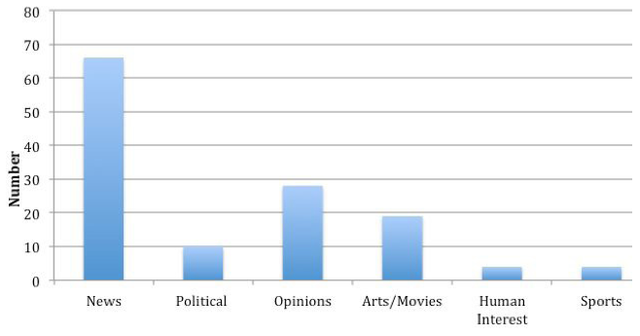From Elon Journal of Undergraduate Research in Communications VOL. 3 NO. 2U.S. Media's Failure to Set the Agenda for Covering Sex TraffickingIII. The New York Times Coverage of Sex TraffickingTo see whether the media have succeeded in, or failed at, setting the agenda, the author counted the number of articles in the New York Times' website archives regarding sex trafficking in the U.S. Not only counting the number of relevant articles, the author analyzed their content to find their story types. The types were divided into "political," "opinion based," "hard news," "art or movies," "human interest" and "sports coverage." Though the agenda setting theory focuses on accessibility and frequency, the types of articles written on sex trafficking in the U.S. could reveal the reason the weight of this issue has not been registered in the public eye. When the author entered "sex trafficking" into the search bar of the New York Times homepage, a total of 5,080 results were generated. When the option of 'articles only' was selected, deleting all blogs from the search, the number came down to 1,030 articles. In comparison, search words of "drug trafficking" generated 11,040 results and 4,530 articles, respectively. Since the focus of this research is on the sex industry over the last 10 years, the author ignored the articles previous to 2000 and had a total of 980 results left. One problem with the search results was due to the different connotation of both human and sex trafficking. Human trafficking was automatically factored into the search results, but did not necessarily correspond to sex trafficking. Some articles used the two interchangeably, which made it more complicated to find specially the articles about sex trafficking. A lot of the results were also connected to drug and organ trafficking. Another error to consider was that searches produced a different number of articles each time the phrase was put into the search bar. After going through each page, the author found only 270 articles specifically focused on the problem of sex trafficking. Among them, 131 referred to the sex industry only in the United States from 2000 to 2012; 88 articles focused only on international incidents; and 51 stories focused on the sex industry both in U.S. and other countries. Figure 1 shows the breakdown of the 131 stories only on the U.S. sex industry: news stories were the most numerous type, followed by opinions, arts, political stories, human interest, and sports. Figure 1. Types of Sex Trafficking Stories in the NYT website.
Frequency of coverage on this topic each year gives insight into the progression of sex trafficking in the media. In 2000 there were no specific articles about sex trafficking in the U.S. The one that referred to the United States was actually an international story on failing to tighten international laws on the problem. In 2001 there were more sex trafficking articles about the industry in Asia, Italy and Cambodia, but only one slightly geared to United States, as they highlighted how passports were being faked to import women into the country and around the world. In 2002 the coverage continued to highlight other countries that were dealing with the problem including the rising problem in Europe and Thailand even with the help from America. One article detailed an arrest of six accused of trafficking women from Mexico for the purpose of selling sex. By 2003 more articles were printed about the sex industry, but any necessary arrests or actual accounts did not come to light. The upcoming 2004 election created some pressure on the Bush administration to tackle the problem, but more on what would be done worldwide. Nationally, the most dramatic was the article The Girl Next Door in 2004. This was the first documented instance of a trafficked girl talking about her situation anonymously, forcing the realization that this happened in America and could be happing next door to you. During 2005 columnist Nicholas Kristof came forward as the leading opinion writer and advocate against sex trafficking. This also marked the increase of opinion articles and letters about the subject. Kristof wrote six opinion pieces within 2005 alone, and continued to write an average of five each year. This was also the first year a movie that had a message on sex trafficking was reviewed. In 2006 the number of opinion articles about sex trafficking outnumbered any other types of articles. The focus of these articles was also still on international problems. Throughout the following six years there were about half a dozen more movies, TV shows or books that tackled the problem through a fictional story line. The attempts to get the attention of those watching a fictional show to this problem could help raise awareness of the topic, but also runs the risk of blinding them to the severity and factuality of the industry. Starting in 2007, the number of articles that focused on the issue in Untied States dramatically increased. The articles, however, were more opinion based and less hard news about the actual arrests of pimps or crackdown of the industry. In consecutive years the number of articles on arrests and the breaking up of brothels increased, but still only made up a small percentage of the total coverage. Also 2007 was the first time an article was written on the Craigslist sex ads. In 2008 2012, except for 2009, several articles were written about Craigslist and other online selling community websites putting up ads for sex. The response from readers on these articles included questioning if those girls were trafficked or chose this as a job, which created a muddled understanding of the horrors of what was going on. In 2009 coverage of domestic and international sex trafficking was almost even, marking a growing shift of awareness. From 2010 on, the author categorized articles on the sex trafficking problem in America and counted the number of stories under each category. The author also counted the total number of articles on other countries' sex industry; however, she did not identify the category of each story. That's why Figure 1 reflects only stories on the domestic sex industry. There have been more articles within the past two years, but they mostly came from the editorial/ opinion section of the paper. In 2010, there were several articles on the response of celebrities or causes that hoped to help raise awareness. The larger number of articles in 2010 was due to one event that generated multiple articles: Americans were jailed in Haiti. While the reason for being jailed centered on sex trafficking, all the follow-up articles focused primarily on their jail time and their release, not necessarily the sex trafficking problem. In both 2011 and 2012, Kristof wrote most articles focusing on sex trafficking. Especially in 2011, he wrote most articles on the breakdown of criminal activity of pimps—totaling four articles. Already in 2012, there have been a large number of articles on the subject. If the previous trend is any guide, there should be an increase in articles on the issue in the U.S. during the rest of the year.Continued on Next Page » Suggested Reading from Inquiries Journal
Inquiries Journal provides undergraduate and graduate students around the world a platform for the wide dissemination of academic work over a range of core disciplines. Representing the work of students from hundreds of institutions around the globe, Inquiries Journal's large database of academic articles is completely free. Learn more | Blog | Submit Latest in Business & Communications |




















